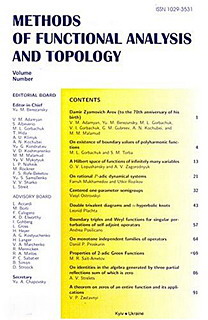Vol. 22 (2016), no. 3
Fractional statistical dynamics and fractional kinetics
José Luís da Silva, Anatoly N. Kochubei, Yuri Kondratiev
MFAT 22 (2016), no. 3, 197-209
197-209
We apply the subordination principle to construct kinetic fractional statistical dynamics in the continuum in terms of solutions to Vlasov-type hierarchies. As a by-product we obtain the evolution of the density of particles in the fractional kinetics in terms of a non-linear Vlasov-type kinetic equation. As an application we study the intermittency of the fractional mesoscopic dynamics.
Actions of finite groups and smooth functions on surfaces
MFAT 22 (2016), no. 3, 210-219
210-219
Let $f:M\to \mathbb{R}$ be a Morse function on a smooth closed surface, $V$ be a connected component of some critical level of $f$, and $\mathcal{E}_V$ be its atom. Let also $\mathcal{S}(f)$ be a stabilizer of the function $f$ under the right action of the group of diffeomorphisms $\mathrm{Diff}(M)$ on the space of smooth functions on $M,$ and $\mathcal{S}_V(f) = \{h\in\mathcal{S}(f)\,| h(V) = V\}.$ The group $\mathcal{S}_V(f)$ acts on the set $\pi_0\partial \mathcal{E}_V$ of connected components of the boundary of $\mathcal{E}_V.$ Therefore we have a homomorphism $\phi:\mathcal{S}(f)\to \mathrm{Aut}(\pi_0\partial \mathcal{E}_V)$. Let also $G = \phi(\mathcal{S}(f))$ be the image of $\mathcal{S}(f)$ in $\mathrm{Aut}(\pi_0\partial \mathcal{E}_V).$ Suppose that the inclusion $\partial \mathcal{E}_V\subset M\setminus V$ induces a bijection $\pi_0 \partial \mathcal{E}_V\to\pi_0(M\setminus V).$ Let $H$ be a subgroup of $G.$ We present a sufficient condition for existence of a section $s:H\to \mathcal{S}_V(f)$ of the homomorphism $\phi,$ so, the action of $H$ on $\partial \mathcal{E}_V$ lifts to the $H$-action on $M$ by $f$-preserving diffeomorphisms of $M$. This result holds for a larger class of smooth functions $f:M\to \mathbb{R}$ having the following property: for each critical point $z$ of $f$ the germ of $f$ at $z$ is smoothly equivalent to a homogeneous polynomial $\mathbb{R}^2\to \mathbb{R}$ without multiple linear factors.
Non-autonomous interacting particle systems in continuum
MFAT 22 (2016), no. 3, 220-244
220-244
A conservative Feller evolution on continuous bounded functions is constructed from a weakly continuous, time-inhomogeneous transition function describing a pure jump process on a locally compact Polish space. The transition function is assumed to satisfy a Foster-Lyapunov type condition. The results are applied to interacting particle systems in continuum, in particular to general birth-and-death processes (including jumps). Particular examples such as the BDLP and Dieckmann-Law model are considered in the end.
On approximation of solutions of operator-differential equations with their entire solutions of exponential type
MFAT 22 (2016), no. 3, 245-255
245-255
We consider an equation of the form $y'(t) + Ay(t) = 0, \ t \in [0, \infty)$, where $A$ is a nonnegative self-adjoint operator in a Hilbert space. We give direct and inverse theorems on approximation of solutions of this equation with its entire solutions of exponential type. This establishes a one-to-one correspondence between the order of convergence to $0$ of the best approximation of a solution and its smoothness degree. The results are illustrated with an example, where the operator $A$ is generated by a second order elliptic differential expression in the space $L_{2}(\Omega)$ (the domain $\Omega \subset \mathbb{R}^{n}$ is bounded with smooth boundary) and a certain boundary condition.
Some results on order bounded almost weak Dunford-Pettis operators
Nabil Machrafi, Aziz Elbour, Mohammed Moussa
MFAT 22 (2016), no. 3, 256-265
256-265
We give some new characterizations of almost weak Dunford-Pettis operators and we investigate their relationship with weak Dunford-Pettis operators.
Foliations with all non-closed leaves on non-compact surfaces
Sergiy Maksymenko, Eugene Polulyakh
MFAT 22 (2016), no. 3, 266-282
266-282
Let $X$ be a connected non-compact $2$-dimensional manifold possibly with boundary and $\Delta$ be a foliation on $X$ such that each leaf $\omega\in\Delta$ is homeomorphic to $\mathbb{R}$ and has a trivially foliated neighborhood. Such foliations on the plane were studied by W. Kaplan who also gave their topological classification. He proved that the plane splits into a family of open strips foliated by parallel lines and glued along some boundary intervals. However W. Kaplan's construction depends on a choice of those intervals, and a foliation is described in a non-unique way. We propose a canonical cutting by open strips which gives a uniqueness of classifying invariant. We also describe topological types of closures of those strips under additional assumptions on $\Delta$.
Homeotopy groups of rooted tree like non-singular foliations on the plane
MFAT 22 (2016), no. 3, 283-294
283-294
Let $F$ be a non-singular foliation on the plane with all leaves being closed subsets, $H^{+}(F)$ be the group of homeomorphisms of the plane which maps leaves onto leaves endowed with compact open topology, and $H^{+}_{0}(F)$ be the identity path component of $H^{+}(F)$. The quotient $\pi_0 H^{+}(F) = H^{+}(F)/H^{+}_{0}(F)$ is an analogue of a mapping class group for foliated homeomorphisms. We will describe the algebraic structure of $\pi_0 H^{+}(F)$ under an assumption that the corresponding space of leaves of $F$ has a structure similar to a rooted tree of finite diameter.


